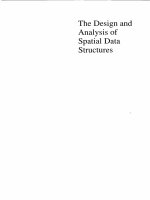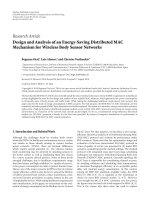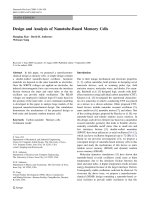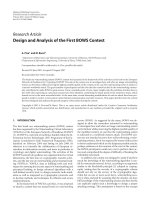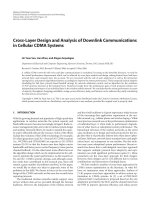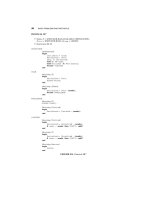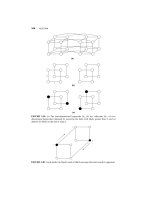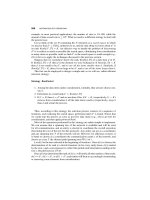DESIGN AND ANALYSIS OF ALGORITHMS, MACHINE LEARNING, BLOCKCHAIN TECHNOLOGY, ELECTIVE III, ELECTIVE IV, LABORATORY PRACTICE III, LABORATORY PRACTICE IV, PROJECT STAGE I
Bạn đang xem bản rút gọn của tài liệu. Xem và tải ngay bản đầy đủ của tài liệu tại đây (2.08 MB, 128 trang )
Faculty of Engineering
Savitribai Phule Pune University, Pune
Maharashtra, India
Curriculum
for
Fourth Year of Computer Engineering
(2019 Course)
(With effect from 2022-23)
www.unipune.ac.in
Faculty of Engineering Savitribai Phule Pune University
Third Year of Computer Engineering
(2019 Course)
(With effect from 2022-23)
Prologue
It is with great pleasure and honor that I share the syllabi for Fourth Year of Computer
Engineering (2019 Course) on behalf of Board of Studies, Computer Engineering. We,
members of BoS are giving our best to streamline the processes and curricula design.
While revising syllabus, honest and sincere efforts are put to tune Computer Engineering
program syllabus in tandem with the objectives of Higher Education of India, AICTE,
UGC and affiliated University (SPPU) by keeping an eye on the technological
advancements and industrial requirements globally.
Syllabus revision is materialized with sincere efforts, active participation, expert
opinions and suggestions from domain professionals. Sincere efforts have been put by
members of BoS, teachers, alumni, industry experts in framing the draft with guidelines
and recommendations.
Case Studies are included in almost all courses. Course Instructor is recommended to
discuss appropriate related recent technology/upgrade/Case Studies to encourage
students to study from course to the scenario and think through the largest issues/ recent
trends/ utility/ developing real world/ professional skills.
I am sincerely indebted to all the minds and hands who work adroitly to materialize
these tasks. I really appreciate your contribution and suggestions in finalizing the
contents.
Thanks,
Dr. Varsha H. Patil
Chairman, Board of Studies (Computer Engineering), SPPU, Pune
links for First Year, Second Year and Third Year Computer Engineering Curriculum 2019:
1. /> ions%20F.E.%202019%20Patt_10.012020.pdf
2. /> ering%202019%20Patt.Syllabus_05.072019.pdf
3. />
202019%20%20Patt_03.072020.pdf
4. />
g%202019%20Pattern_16022022.rar
Syllabus for Fourth Year of Computer Engineering ` #2/128
Faculty of Engineering Savitribai Phule Pune University
Savitribai Phule Pune University
Third Year of Computer Engineering (2019 Course)
(With effect from Academic Year 2021-22)
Table of Contents
Sr. No. Title Page
Number
1. Program Outcomes
5
2. Program Specific Outcomes 5
6
3. Course Structure
8
(Course titles, scheme for teaching, credit, examination and marking)
11
4. General Guidelines 14
18
5. Course Contents (Semester V) 21
24
410241: Design and Analysis of Algorithms 27
30
410242:Machine Learning 33
36
410243: Blockchain Technology 40
43
410244A: Pervasive Computing 46
50
410244B: Multimedia Techniques 53
57
410244C: Cyber Security And Digital Forensics 65
66
410244D: Object Oriented Modeling And Design
73
410244E: Digital Signal Processing 76
79
410245A: Information Retrieval 82
85
410245B: GPU Programming And Architecture
#3/128
410245C: Mobile Computing
410245D: Software Testing And Quality Assurance
410245E: Compilers
410246: Laboratory Practice III
410247: Laboratory Practice IV
410248: Project Stage I
410249: Audit Course 7
6. Course Contents (Semester VI)
410250: High Performance Computing
410251: Deep Learning
410252A: Natural Language Processing
410252B: Image Processing
410252C: Software Defined Networks
Syllabus for Fourth Year of Computer Engineering `
Faculty of Engineering Savitribai Phule Pune University
410253D: Advanced Digital Signal Processing 88
410252E: Open Elective 91
410253A: Pattern Recognition 92
410253B: Soft Computing 95
410253C:Buisness Intelligence 98
410253D:Quantum Computing 103
410253E: Open Elective 106
107
410254: Laboratory Practice V 111
120
410255: Laboratory Practice VI 121
127
410256: Project Stage II 128
410257: Audit Course 8
7. Acknowledgement
8. Task Force at Curriculum Design
Syllabus for Fourth Year of Computer Engineering ` #4/128
Faculty of Engineering Savitribai Phule Pune University
Savitribai Phule Pune University
Bachelor of Computer Engineering
Program Outcomes (POs)
Learners are expected to know and be able to–
PO1 Engineering Apply the knowledge of mathematics, science, Engineering fundamentals, and an Engineering
knowledge specialization to the solution of complex Engineering problems.
PO2 Problem analysis Identify, formulate, review research literature, and analyze complex Engineering problems
reaching substantiated conclusions using first principles of mathematics natural sciences, and
Engineering sciences.
PO3 Design / Design solutions for complex Engineering problems and design system components or
Development of processes that meet the specified needs with appropriate consideration for the public health and
Solutions safety, and the cultural, societal, and Environmental considerations.
PO4 Conduct Use research-based knowledge and research methods including design of experiments, analysis
Investigations of and interpretation of data, and synthesis of the information to provide valid conclusions.
PO5 Complex
PO6 Problems Create, select, and apply appropriate techniques, resources, and modern Engineering and IT
PO7 Modern Tool tools including prediction and modeling to complex Engineering activities with an
PO8 Usage understanding of the limitations.
PO9
PO10 The Engineer and Apply reasoning informed by the contextual knowledge to assess societal, health, safety, legal
PO11 Society and cultural issues and the consequent responsibilities relevant to the professional engineering
PO12 practice.
Environment and
Sustainability Understand the impact of the professional Engineering solutions in societal and Environmental
Ethics contexts, and demonstrate the knowledge of, and need for sustainable development.
Apply ethical principles and commit to professional ethics and responsibilities and norms of
Individual and the Engineering practice.
Team Work Function effectively as an individual, and as a member or leader in diverse teams, and in
Communication multidisciplinary settings.
Skills Communicate effectively on complex Engineering activities with the Engineering community
and with society at large, such as, being able to comprehend and write effective reports and
Project design documentation, make effective presentations, and give and receive clear instructions.
Management and Demonstrate knowledge and understanding of the Engineering and management principles and
Finance apply these to one’s own work, as a member and leader in a team, to manage projects and in
Life-long multidisciplinary Environments.
Learning Recognize the need for, and have the preparation and ability to engage in independent and life-
long learning in the broadest context of technological change.
Program Specific Outcomes (PSO)
PSO1 Professional Skills-The ability to understand, analyze and develop computer programs in the areas related to
PSO2 algorithms, system software, multimedia, web design, big data analytics, and networking for efficient design of
PSO3 computer-based systems of varying complexities.
Problem-Solving Skills- The ability to apply standard practices and strategies in software project development using
open-ended programming environments to deliver a quality product for business success.
Successful Career and Entrepreneurship- The ability to employ modern computer languages, environments, and
platforms in creating innovative career paths to be an entrepreneur, and a zest for higher studies.
Syllabus for Fourth Year of Computer Engineering ` #5/128
Faculty of Engineering Savitribai Phule Pune University
BE Computer Engineering 2019 Course tentative Curriculum structure:
Savitribai Phule Pune University
Final Year of Computer Engineering (2019 Course)
(With effect from Academic Year 2022-23)
Semester VII
Course Course Name Teaching Examination Scheme and Marks Credit Scheme
Code Scheme
(Hours/wee
k)
Lecture
Practical
Tutorial
Mid-Sem
End-Sem
Term work
Practical
Oral\Pre
Total
Lecture
Practical
Tutorial
Total
410241 Design and Analysis of 03 - - 30 70 - - - 100 3 - - 3
Algorithms
410242 Machine Learning 03 - - 30 70 - - - 100 3 - - 3
410243 Blockchain Technology 03 - - 30 70 - - - 100 3 - - 3
410244 Elective III 03 - - 30 70 - - - 100 3 - - 3
410245 Elective IV 03 - - 30 70 - - - 100 3 - - 3
410246 Laboratory Practice III - 04 - - - 50 50 - 100 - 2 - 2
410247 Laboratory Practice IV - 02 - - - 50 - - 50 - 1 - 1
410248 Project Stage I - 02 - - - 50 - - 50 - 2 - 2
Total Credit 15 05 - 20
Total 15 08 - 150 350 150 50 - 700 15 05 - 20
410249 Audit Course 7 Grade
Elective III Elective IV
410244(A) Pervasive Computing 410245(A) Information Retrieval
410244(B) Multimedia Techniques 410245(B) GPU Programming and Architecture
410244(C) Cyber Security and Digital Forensics 410245(C) Mobile Computing
410244(D) Object Oriented Modeling and Design 410245(D)Software Testing and Quality
410244(E) Digital Signal Processing Assurance
410245(E) Compilers
Laboratory Practice III: Laboratory Practice IV:
Laboratory assignments Courses- 410241, 410242, Laboratory assignments Courses- 410244, 410245
410243
Audit Course 7(AC7) Options:
AC7- I MOOC- Learn New Skills
AC7- II Entrepreneurship Development
AC7- III Botnet of Things
AC7- IV 3D Printing
AC7- V Industrial Safety and Environment Consciousness
Syllabus for Fourth Year of Computer Engineering ` #6/128
Faculty of Engineering Savitribai Phule Pune University
Savitribai Phule Pune University
Final Year of Computer Engineering (2019 Course)
(With effect from Academic Year 2022-23)
Semester VIII
Course Course Name Teaching Examination Scheme and Marks Credit Scheme
Code Scheme
(Hours/wee
k)
Lecture
Practical
Tutorial
Mid-Sem
End-Sem
Term
work
Practical
Oral/Pre
Total
Lecture
Practical
Tutorial
Total
410250 High Performance 03 - - 30 70 - - - 100 03 03
Computing
410251 Deep Learning 03 - - 30 70 - - - 100 03 03
410252 Elective V 03 - - 30 70 - - - 100 03 03
410253 Elective VI 03 - - 30 70 - - - 100 03 03
410254 Laboratory Practice V - 02 - - - 50 50 - 100 01 01
410255 Laboratory Practice VI - 02 - - - 50 - - 50 01 01
410256 Project Stage II - 06 - - - 100 - 50 150 06 06
Total Credit 12 08 - 20
Total 12 10 - 120 280 200 50 50 700 12 08 - 20
410257 Audit Course 8 Grade
Elective V Elective VI
410252(A) Natural Language Processing 410253(A) Pattern Recognition
410252(B) Image Processing 410253(B) Soft Computing
410252(C) Software Defined Networks 410253(C) Business Intelligence
410252(D) Advanced Digital Signal Processing 410253(D) Quantum Computing
410252(E) Open Elective 410253(E) Open Elective
Lab Practice V:
Laboratory assignments Courses- 410250, 410251 Lab Practice VI:
Laboratory assignments Courses- 410252, 410253
Audit Course 8(AC8) Options:
AC8- I Usability Engineering
AC8- II Conversational Interfaces
AC8- II Social Media and Analytics
AC8- IV MOOC- Learn New Skills
AC8- V Emotional Intelligence
Syllabus for Fourth Year of Computer Engineering ` #7/128
Faculty of Engineering Savitribai Phule Pune University
General Guidelines
1. Every undergraduate program has its own objectives and educational outcomes. These objectives and outcomes are
furnished by considering various aspects and impacts of the curriculum. These Program Outcomes (POs) are
categorically mentioned at the beginning of the curriculum (ref: NBA Manual). There should always be a rationale and a
goal behind the inclusion of a course in the curriculum. Course Outcomes though highly rely on the contents of the
course, many a times are generic and bundled. The Course Objectives, Course Outcomes and CO-PO mappings
matrix justifies the motives, accomplishment and prospect behind learning the course. The Course Objectives, Course
Outcomes and CO-PO Mapping Matrix are provided for reference and these are indicative only. The course instructor
may modify them as per his or her perspective.
2. @CO and PO Mapping Matrix(Course Objectives and Program Outcomes) attainment mapping matrix at end of
course contents, indicates the correlation levels of 3, 2, 1 and ‘-‘. The notation of 3, 2 and 1 denotes substantially (high),
moderately (medium) and slightly (low). The mark ‘-‘ indicates that there isno correlation between CO and PO.
3. For each course, contents are divided into six units-I, II, III, IV, V and VI.
#Elaborated examples/Case Studies are included at each unit to explore how the learned topics apply to real world
situations and need to be explored so as to assist students to increase their competencies, inculcating the specific skills,
building the knowledge to be applicable in any given situation along with an articulation. One or two sample exemplars
or case studies are included for each unit; instructor may extend the same with more. Exemplar/Case Studies may be
assigned as self-study by students and to be excluded from theory examinations.
4. *For each unit contents, the content attainment mapping is indicated with Course Outcome(s). Instructor may revise
the same as per their viewpoint.
5. For laboratory courses, set of suggested assignments is provided for reference. Laboratory Instructors may design
suitable set of assignments for respective course at their level. Beyond curriculum assignments and mini-project may be
included as the part of laboratory work. Inclusion of it will be the value addition for the students and it will satisfy the
intellectuals within the group of the learners and will add to the perspective of the learners.
6. For each laboratory assignment, it is essential for students to draw/write/generate flowchart, algorithm, test cases,
mathematical model, Test data set and comparative/complexity analysis (as applicable). Batch size for practical and
tutorial may be as per guidelines of authority.
7. For each course, irrespective of the examination head, the instructor should motivate students to read
articles/research papers related to recent development and invention in the field.
8. For laboratory, instructions have been included about the conduction and assessment of laboratory work. These
guidelines are to be strictly followed.
9. Term Work –Term work is continuous assessment that evaluates a student's progress throughout the
semester. Term work assessment criteria specify the standards that must be met and the evidence that will be gathered to
demonstrate the achievement of course outcomes. Categorical assessment criteria for the term work should establish
unambiguous standards of achievement for each course outcome. They should describe what the learner is expected to
perform in the laboratories or on the fields to show that the course outcomes have been achieved.
Students’ work will be evaluated typically based on the criteria like attentiveness, proficiency in execution of the task,
regularity, punctuality, use of referencing, accuracy of language, use of supporting evidence in drawing conclusions,
quality of critical thinking and similar performance measuring criteria.
10. Program codes with sample output of all performed assignments are to be submitted as softcopy. Use of DVD
or similar media containing students programs maintained by Laboratory In-charge is highly encouraged. For
reference one or two journals may be maintained with program prints at Laboratory. As a conscious effort and
little contribution towards Green IT and environment awareness, attaching printed papers as part of write-ups
and program listing to journal may be avoided. Submission of journal/ term work in the form of softcopy is
desirable and appreciated.
Abbreviations
TW: Term Work TH: Theory PR: Practical
OR: Oral Sem: Semester
`
Syllabus for Fourth Year of Computer Engineering #8/128
Faculty of Engineering Savitribai Phule Pune University
Faculty of Engineering Savitribai Phule Pune University
SEMESTER VII
Syllabus for Fourth Year of Computer Engineering ` #9/128
Faculty of Engineering Savitribai Phule Pune University Home
Savitribai Phule Pune University
Fourth Year of Computer Engineering (2019 Course)
410241: Design and Analysis of Algorithms
Teaching Scheme: Credit Examination Scheme:
TH: 03 Hours/Week 03 In-Sem (Paper): 30 Marks
End-Sem (Paper): 70 Marks
Prerequisites Courses: Discrete Mathematics (210241), Fundamentals of Data
Structures(210242, Data Structures and Algorithms(210252), Theory of Computation ( 310242)
Companion Course: Laboratory Practice III(410246)
Course Objectives:
To develop problem solving abilities using mathematical theories.
To apply algorithmic strategies while solving problems.
To analyze performance of different algorithmic strategies in terms of time and space.
To develop time and space efficient algorithms.
To study algorithmic examples in distributed and concurrent environments
To Understand Multithreaded and Distributed Algorithms
Course Outcomes:
On completion of the course, student will be able to–
CO1: Formulate the problem
CO2: Analyze the asymptotic performance of algorithms
CO3: Decide and apply algorithmic strategies to solve given problem
CO4: Find optimal solution by applying various methods
CO5: Analyze and Apply Scheduling and Sorting Algorithms.
CO6: Solve problems for multi-core or distributed or concurrent environments
Course Contents
Unit I Algorithms and Problem Solving 07 Hours
Algorithm: The Role of Algorithms in Computing - What are algorithms, Algorithms as
technology, Evolution of Algorithms, Design of Algorithm, Need of Correctness of Algorithm,
Confirming correctness of Algorithm – sample examples, Iterative algorithm design issues.
Problem solving Principles: Classification of problem, problem solving strategies, classification of
timecomplexities (linear, logarithmic etc.)
#Exemplar/Case Studies Towers of Hanoi
*Mapping of Course CO1,CO3
Outcomes for Unit I
Unit II Analysis of Algorithms and Complexity Theory 07 Hours
Analysis: Input size, best case, worst case, average case
Counting Dominant operators, Growth rate, upper bounds, asymptotic growth, O, Ω, Ɵ, o and ω
notations, polynomial and non-polynomial problems, deterministic and non-deterministic
algorithms, P- class problems, NP-class of problems, Polynomial problem reduction NP complete
problems- vertex cover and 3-SAT and NP hard problem - Hamiltonian cycle.
#Exemplar/Case Analysis of iterative and recursive algorithm
Studies
Syllabus for Fourth Year of Computer Engineering ` #10/128
Faculty of Engineering Savitribai Phule Pune University
*Mapping of Course CO2
Outcomes for Unit II
Unit III Greedy And Dynamic Programming algorithmic Strategie0s8 Hours
Greedy strategy: Principle, control abstraction, time analysis of control abstraction, knapsack
problem,scheduling algorithms-Job scheduling and activity selection problem.
Dynamic Programming: Principle, control abstraction, time analysis of control abstraction,
binomialcoefficients, OBST, 0/1 knapsack, Chain Matrix multiplication.
#Exemplar/Case Rail tracks connecting all the cities 08 Hours
Studies CO3, CO4
*Mapping of Course Backtracking and Branch-n-Bound
Outcomes for Unit
III
Unit IV
Backtracking: Principle, control abstraction, time analysis of control abstraction, 8-queen
problem,graph coloring problem, sum of subsets problem.
Branch-n-Bound: Principle, control abstraction, time analysis of control abstraction, strategies-
FIFO,
LIFO and LC approaches, TSP, knapsack problem.
#Exemplar/Case Airline Crew Scheduling
Studies CO3, CO4
*Mapping of Course
Outcomes for Unit IV
Unit V Amortized Analysis 07 Hours
Amortized Analysis: Aggregate Analysis, Accounting Method, Potential Function method,
Amortized analysis-binary counter, stack Time-Space tradeoff, Introduction to Tractable and Non-
tractable Problems, Introduction to Randomized and Approximate algorithms, Embedded
Algorithms: Embedded system scheduling (power optimized scheduling algorithm), sorting
algorithm for embedded systems.
#Exemplar/Case cutting stock problem
Studies
*Mapping of Course CO3,CO5
Outcomes for Unit V
Unit VI Multithreaded And Distributed Algorithms 07 Hours
Multithreaded Algorithms - Introduction, Performance measures, Analyzing multithreaded
algorithms,Parallel loops, Race conditions.
Problem Solving using Multithreaded Algorithms - Multithreaded matrix multiplication,
Multithreadedmerge sort.
Distributed Algorithms - Introduction, Distributed breadth first search, Distributed Minimum
Spanning Tree.
String Matching- Introduction, The Naive string matching algorithm, The Rabin-Karp algorithm.
#Exemplar/Case Plagiarism detection
Studies
Syllabus for Fourth Year of Computer Engineering ` #11/128
Faculty of Engineering Savitribai Phule Pune University
*Mapping of Course CO6 Home
Outcomes for UnitVI
Learning Resources
Text Books:
1. Parag Himanshu Dave, Himanshu Bhalchandra Dave, “ Design And Analysis of
Algorithms”,Pearson Education, ISBN 81-7758-595-9
2. Gilles Brassard, Paul Bratley, “Fundamentals of Algorithmics”, PHI, ISBN 978-81-203-1131-2
Reference Books :
1. Michael T. Goodrich, Roberto Tamassia, “Algorithm Design: Foundations,” Analysis and
InternetExamples‖, Wiley, ISBN 978-81-265-0986-7
2. Thomas H. Cormen, Charles E. Leiserson, Ronald L. Rivest and Clifford Stein, “ Introduction
toAlgorithms”, MIT Press; ISBN 978-0-262-03384-8
3. Horowitz and Sahani, "Fundamentals of Computer Algorithms", University Press, ISBN: 978
817371 6126, 81 7371 61262
4. Rajeev Motwani and Prabhakar Raghavan, “Randomized Algorithms” Cambridge University Press,
ISBN: 978-0-521-61390-3
5. Dan Gusfield, “Algorithms on Strings, Trees and Sequences”, Cambridge University Press,ISBN:0-
521-67035-7
e-B ooks :
1. /> sis_of_algorithms_tutorial.pdf
2. /> analysis/m-h-alsuwaiyel
MOOC Courses links :
Design and Analysis of Algorithms - />
@The CO-PO Mapping Matrix
CO/ PO2 PO3 PO4 PO5 PO6 PO7 PO8 PO9 PO10 PO11 PO12
PO PO1
CO1 1 2 - - - - - - - - - 2
CO2 2 3 - - - - - - - - - 2
CO3 2 3 2 - - - - - - - - 3
CO4 2 3 3 2 - - - - - - - 3
CO5 2 2 2 2 - - - - - - - 3
CO6 2 2 1 2 - - - - - - - -
Syllabus for Fourth Year of Computer Engineering ` #12/128
Faculty of Engineering Savitribai Phule Pune University Home
Savitribai Phule Pune University
Fourth Year of Computer Engineering (2019 Course)
410242: Machine Learning
Teaching Scheme: Credit Examination Scheme:
TH: 03 Hours/Week 03 In-Sem (Paper): 30 Marks
End-Sem (Paper): 70 Marks
Prerequisite Courses: Data Science and Big Data Analytics(310251)
Companion Course: Laboratory Practice III(410246)
Course Objectives:
To understand the need for Machine learning
To explore various data pre-processing methods.
To study and understand classification methods
To understand the need for multi-class classifiers.
To learn the working of clustering algorithms
To learn fundamental neural network algorithms.
Course Outcomes:
On completion of the course, student will be able to–
CO1: Identify the needs and challenges of machine learning for real time applications.
CO2: Apply various data pre-processing techniques to simplify and speed up machine
learning algorithms.
CO3: Select and apply appropriately supervised machine learning algorithms for
real timeapplications.
CO4: Implement variants of multi-class classifier and measure its performance.
CO5 :Compare and contrast different clustering algorithms.
CO6: Design a neural network for solving engineering problems.
Course Contents
Unit I Introduction To Machine Learning 07 Hours
Introduction to Machine Learning, Comparison of Machine learning with traditional
programming, ML vs AI vs Data Science.
Types of learning: Supervised, Unsupervised, and semi-supervised, reinforcement learning
techniques, Models of Machine learning: Geometric model, Probabilistic Models, Logical Models,
Grouping and grading models, Parametric and non-parametric models.
Important Elements of Machine Learning- Data formats, Learnability, Statistical learning
approaches
#Exemplar/Case Studies Suppose you are working for Uber where a task to increase sales is
given.Understand the requirements of the client
*Mapping of Course CO1
Outcomes for Unit
Feature Engineering 07 Hours
Unit II
Syllabus for Fourth Year of Computer Engineering ` #13/128
Faculty of Engineering Savitribai Phule Pune University
Concept of Feature, Preprocessing of data: Normalization and Scaling, Standardization, Managing
missing values, Introduction to Dimensionality Reduction, Principal Component Analysis (PCA),
Feature Extraction: Kernel PCA, Local Binary Pattern.
Introduction to various Feature Selection Techniques, Sequential Forward Selection, Sequential
Backward Selection.
Statistical feature engineering: count-based, Length, Mean, Median, Mode etc. based feature
vector creation.
Multidimensional Scaling, Matrix Factorization Techniques.
#Exemplar/CaseStudies You are a Data Scientist, and a client comes to you with their
data. Client is running a few campaigns from the past few
months, but no campaign seemseffective. Client provides you the
data of customers, product sales and past campaign success.
They want to increase their sales and figure out which marketing
strategy isworking the best for them?
Questions for data scientists:
1. What data analysis approach will you follow?
2. What statistical approach do you need to follow?
How will you select important features?
*Mapping of Course CO2
Outcomes for Unit II
Unit III Supervised Learning : Regression 06 Hours
Bias, Variance, Generalization, Underfitting, Overfitting, Linear regression, Regression: Lasso
regression, Ridge regression, Gradient descent algorithm.
Evaluation Metrics: MAE, RMSE, R2
#Exemplar/Case Studies Stock market price prediction
*Mapping of Course CO3 08 Hours
Outcomes for Unit III Supervised Learning : Classification
Unit IV
Classification: K-nearest neighbour, Support vector machine.
Ensemble Learning: Bagging, Boosting, Random Forest,
Adaboost.
Binary-vs-Multiclass Classification, Balanced and Imbalanced Multiclass Classification
Problems,Variants of Multiclass Classification: One-vs-One and One-vs-All
Evaluation Metrics and Score: Accuracy, Precision, Recall, Fscore, Cross-validation, Micro-
Recall,
Average Precision and Recall, Micro-Average F-score, Macro-Average Precision and
Macro-Average F-score.
#Exemplar/Case Studies Prediction of Thyroid disorders such as Hyperthyroid,
Hypothyroid, Euthyroid-sick,and Euthyroid using multiclass
classifier.
*Mapping of Course CO4
Outcomes for Unit IV
Unit V Unsupervised Learning 07 Hours
K-Means, K-medoids, Hierarchical, and Density-based Clustering, Spectral Clustering. Outlier
analysis: introduction of isolation factor, local outlier factor.
Evaluation metrics and score: elbow method, extrinsic and intrinsic methods
Syllabus for Fourth Year of Computer Engineering ` #14/128
Faculty of Engineering Savitribai Phule Pune University
#Exemplar/Case Studies Market basket analysis/Customer Segmentation
*Mapping of Course CO5 07 Hours
Outcomes for Unit V Introduction To Neural Networks
Unit VI
Artificial Neural Networks: Single Layer Neural Network, Multilayer Perceptron, Back
Propagation Learning, Functional Link Artificial Neural Network, and Radial Basis Function
Network, Activation functions,
Introduction to Recurrent Neural Networks and Convolutional Neural Networks
#Exemplar/Case Studies Movie Recommendation System
*Mapping of Course CO6
Outcomes for Unit VI Learning Resources
Text Books:
1. Bishop, Christopher M., and Nasser M. Nasrabadi, “Pattern recognition and machine
learning”,Vol. 4.No. 4. New York: springer, 2006.
2. Ethem Alpaydin, “ Introduction to Machine Learning”, PHI 2nd Edition-2013
Reference Books:
1. Tom Mitchell, “ Machine learning”, McGraw-Hill series in Computer Science, 1997
2. Shalev-Shwartz, Shai, and Shai Ben-David, “Understanding machine learning: From
theory toalgorithms”, Cambridge university press, 2014.
3. Jiawei Han, Micheline Kamber, and Jian Pie, “Data Mining: Concepts and
Techniques”, Elsevier Publishers Third Edition, ISBN: 9780123814791,
9780123814807
4. Hastie, Trevor, et al., “The elements of statistical learning: data mining, inference, and
prediction”, Vol. 2. New York: springer, 2009.
5. McKinney, “Python for Data Analysis “,O' Reilly media, ISBN : 978-1-449-31979-3
6. Trent hauk, “Scikit-learn”, Cookbook , Packt Publishing, ISBN: 9781787286382
7. Goodfellow I.,Bengio Y. and Courville, “ A Deep Learning”, MIT Press, 2016
e-Books :
1. Python Machine Learning : /> content/uploads/sites/25/2019/03/207_05_01_Rajchka_Using-Python-for-machine-
learning-2015.pdf
2. Foundation of Machine Learning: /> 3. Dive into Deep Learning: /> 4. A brief introduction to machine learning for Engineers: /> 5. Feature selection: /> 6. Introductory Machine Learning Nodes : />MOOC Courses Links:
Introduction to Machine Learning : />
Introduction to Machine Learning (IIT Madras):
/>
Deep learning: />
Syllabus for Fourth Year of Computer Engineering ` #15/128
Faculty of Engineering @The CO-PO Mapping Matrix Savitribai Phule Pune University
CO\PO PO1 PO2 PO3 PO4 PO5 PO6 PO7 PO8 PO9 PO10 PO11 PO12
CO1
CO2 2 - - 2 - - 1 1 1 1 1 1
CO3
CO4 2 1 - 1 1 1 1 1 1 1 1 1
CO5
CO6 2 2 2 1 1 1 1 1 1 1 1 1
2 2 2 1 1 1 1 1 1 1 1 1
2 2 2 1 1 1 1 1 1 1 1 1
2 - 2 1 1 1 1 1 1 1 1 1
Syllabus for Fourth Year of Computer Engineering ` #16/128
Faculty of Engineering Savitribai Phule Pune University
Savitribai Phule Pune University Home
home
Fourth Year of Computer Engineering (2019 Course)
410243: Blockchain Technology
Teaching Scheme: Credit Examination Scheme:
TH: 03 Hours/Week 03 In-Sem (Paper): 30 Marks
End-Sem (Paper): 70 Marks
Prerequisite Courses: Computer Networks and Security(310244)
Companion Course: Laboratory Practice III(410246)
Course Objectives:
Technology behind Blockchain
Crypto currency, Bitcoin and Smart contracts
Different consensus algorithms used in Blockchain
Real-world applications of Blockchain
To analyze Blockchain Ethereum Platform using Solidity
To Describe Blockchain Case Studies
Course Outcomes:
On completion of the course, student will be able to–
CO1: Interpret the fundamentals and basic concepts in Blockchain
CO2: Compare the working of different blockchain platforms
CO3: Use Crypto wallet for cryptocurrency based transactions
CO4: Analyze the importance of blockchain in finding the solution to the real-world
problems.
CO5: Illustrate the Ethereum public block chain platform
CO6: Identify relative application where block chain technology can be effectively used
and implemented.
Course Contents
Unit I Mathematical Foundation for Blockchain 06 Hours
Cryptography: Symmetric Key Cryptography and Asymmetric Key Cryptography, Elliptic Curve
Cryptography (ECC), Cryptographic Hash Functions: SHA256, Digital Signature Algorithm
(DSA), Merkel Trees.
#Exemplar/Case Studies Compare the Symmetric and Asymmetric Cryptography algorithms
*Mapping of Course CO1 07 Hours
Outcomes for Unit I Feature Engineering
Unit II
History, Centralized Vs. Decentralized Systems, Layers of Blockchain: Application Layer,
Execution Layer, Semantic Layer, Propagation Layer, Consensus Layer, Why is Block chain
important? Limitations of Centralized Systems, Blockchain Adoption So Far.
Syllabus for Fourth Year of Computer Engineering ` #17/128
Faculty of Engineering Savitribai Phule Pune University
#Exemplar/CaseStudies Study of a research paper based on Blockchain.
*Mapping of Course CO1
Outcomes for Unit II
Unit III Blockchain Platforms and Consensus in Blockchain 06 Hours
Types of Blockchain Platforms: Public, Private and Consortium, Bitcoin, Ethereum,
Hyperledger,IoTA, Corda, R3.
Consensus in Blockchain: Consensus Approach, Consensus Elements, Consensus
Algorithms, Proof of Work, Byzantine General problem, Proof of Stake, Proof of Elapsed
Time, Proof of
Activity, Proof of Burn.
#Exemplar/Case Studies Compare different consensus algorithms used in Blockchain
Technology.
*Mapping of Course CO2
Outcomes for Unit III
Unit IV Cryptocurrency – Bitcoin, and Token 06 Hours
Introduction, Bitcoin and the Cryptocurrency, Cryptocurrency Basics
Types of Cryptocurrency, Cryptocurrency Usage, Cryptowallets: Metamask, Coinbase, Binance
#Exemplar/Case Studies Create your own wallet for crypto currency using any of the
Blockchain Platforms.
*Mapping of Course CO3
Outcomes for Unit IV
Unit V Blockchain Ethereum Platform using Solidity 06 Hours
What is Ethereum, Types of Ethereum Networks, EVM (Ethereum Virtual Machine), Introduction
to smart contracts, Purpose and types of Smart Contracts, Implementing and deploying smart
contracts using Solidity, Swarm (Decentralized Storage Platform),
Whisper (Decentralized Messaging Platform)
#Exemplar/Case Studies Study Truffle Development Environment.
*Mapping of Course CO4 06 Hours
Outcomes for Unit V Blockchain Case Studies
Unit VI
Prominent Blockchain Applications, Retail, Banking and Financial Services, Government
Sector, Healthcare, IOT, Energy and Utilities, Blockchain Integration with other Domains
#Exemplar/Case Studies Study 2 uses cases of Blockchain and write a detailed report on
every aspect implemented in the same
*Mapping of Course CO5, CO6
Outcomes for Unit VI
Learning Resources
Syllabus for Fourth Year of Computer Engineering ` #18/128
Faculty of Engineering Savitribai Phule Pune University
Text Books:
1. Martin Quest, “Blockchain Dynamics: A Quick Beginner's Guide on Understanding the
Foundations of Bit coin and Other Crypto currencies”, Create Space Independent
PublishingPlatform, 15-May-2018
2. Imran Bashir, “Mastering Blockchain: Distributed Ledger Technology, Decentralization
and Smart Contracts Explained”, Second Edition, Packt Publishing, 2018
3. Alex Leverington, “Ethereum Programming”, Packt Publishing, 2017
Reference Books:
1. Bikramaditya Singhal, Gautam Dhameja, Priyansu Sekhar Panda, "Beginning Blockchain
ABeginner’s Guide to Building Blockchain Solutions",2018
2. Chris Dannen, "Introducing Ethereum and Solidity", Foundations of Crypto currency
andBlockchain Programming for Beginners
3. Daniel Drescher, "Blockchain Basics", A Non -Technical Introduction in 25Steps.
4. Ritesh Modi, “Solidity Programming Essentials”, Packt Publishing,2018
5. Chandramouli Subramanian, Asha A George, Abhilash K A and Meena Karthikeyan,
“Blockchain Technology”, Universities Press, ISBN-9789389211634
e-Books :
1. /> Edition.pdf
2. /> 3. />
MOOC Courses Links:
1. NPTEL Course on “Introduction to Blockchain Technology & Applications”
/> 2. NPTEL Course on b
/>
@The CO-PO Mapping Matrix
CO\PO PO1 PO2 PO3 PO4 PO5 PO6 PO7 PO8 PO9 PO10 PO11 PO12
CO1
CO2 3 - - - - - - - - - - -
CO3 3 - - -
CO4 - - - - - - - -
CO5
CO6 3 - 2 2 - - - - - - - -
3 - 2 - 2 - - - - - - -
3 3 2 - - - - - - - - 2
2 2 2 2- - - - - - - -
Syllabus for Fourth Year of Computer Engineering ` #19/128
Faculty of Engineering Savitribai Phule Pune University Home
Savitribai Phule Pune University
Fourth Year of Computer Engineering (2019 Course)
410244(A): Pervasive Computing
Teaching Scheme: Credit Examination Scheme:
TH: 03 Hours/Week 03 In-Sem (Paper): 30 Marks
End-Sem (Paper): 70 Marks
Prerequisite Courses: -Internet of Thigs and Embedded Systems(310245A)
Companion Course: Laboratory Practice IV(410247)
Course Objectives:
To introduce the characteristics, basic concepts and systems issues in pervasive computing.
To illustrate smart devices and architectures in pervasive computing.
To introduce intelligent systems and interactions in Pervasive computing.
To identify the trends and latest development of the technologies in the area.
To Understand Interaction Design – HCI and Wearable Computing Environment.
To identify Security Challenges & Ethics in Pervasive Computing
Course Outcomes:
On completion of the course, student will be able to–
CO1.Demonstrate fundamental concepts in pervasive computing.
CO2.Explain pervasive devices and decide appropriate one as per the need of real
timeapplications.
CO3.Classify and analyze context aware systems for their efficiency in different ICT
systems.
CO4.Illustrate intelligent systems and generic intelligent interactive applications.
CO5.Design HCI systems in pervasive computing environment.
CO6.Explore the security challenges and know the role of ethics in the
context of pervasivecomputing.
Course Contents
Unit I Introduction To Pervasive Computing 07 Hours
Pervasive Computing: History, Principles, Characteristics, Problems/Issues & Challenges,
Advantages of Pervasive Computing
Pervasive Computing Applications: Pervasive computing devices and interfaces, Device
technology trends, Connecting issues and protocols.
#Exemplar/Case Studies Pervasive Computing for Personalized medicine
*Mapping of Course CO1
Outcomes for Unit I
Unit II Smart Computing with Pervasive Computing Devices 07 Hours
Smart Devices: CCI, Smart Environment: CPI and CCI, Smart Devices: iHCI and HPI,
Wearable devices, Application and Requirements, Device Technology and Connectivity, PDA
Device characteristics - PDA Based Access Architecture, Voice Enabling Pervasive
Computing: Voice Standards, Speech Applications in Pervasive Computing.
#Exemplar/CaseStudies Amazon Alexa
Syllabus for Fourth Year of Computer Engineering ` #20/128
